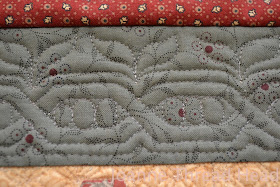I was inspired by Raewyn (Love to Stitch) to get caught up, and keep up before the end of the month.
It is supposed to have 12 blocks, but I only made 6. It is about 12" x 15".
I added lots of quilting.
 |
| I stitched in the ditch first - ESS |
I marked a 1/2" grid with a ruler and a Hera marker,
and quilted Cathedral Windows. I love how the hexagon flowers look like they are trapunto. I used a layer of cotton batting with a half layer of wool batting on top.
I also used this stencil (marked with quilt pounce),
 |
| looks like DNA strands |
but added some extra details - Cindy Needham style!
Since the Craftsy class it has been interesting to think of different ways to use the few stencils that I have.
In the corners I added a feather swirl. You can see that the binding was already sewn on, but not stitched to the back yet (I don't usually cut the backing and batting to size before I bind a quilt, and so there was space to hold the quilt when quilting). Adding the binding before quilting makes sure that the design fills the area, and won't get cut off.
I used a white board to figure out how the design was going to work.
The hexagon flowers were quilted with a feather wreath. They are such tiny hexagons (3" across) that I left the centres puffy, with no quilting.
Graph paper to make hexagons can be found here, the link is from the book, and a great site to bookmark.
I also finished the September Small Quilt of the Month - This quilt is free on Kathleen Tracy's web site. It is 21" square. Just cotton batting in this one, I wanted the crinkled look.
I like the fabric I used, but I realize now that some of them are too close in colour value, and so the quilt looks odd. Oh well, live and learn!
I thought this quilt would be a good opportunity to try out some different quilting designs. I quilted designs that I had never quilted before. I thought that the shapes in the big squares looked like sea weed. Sometimes I end up with designs that I can use again, and sometimes not, but it is all fun. I did FMQ a quote from Diane Gaudynski around the border - Keep quilting, your work gets better everyday, just to try something else new.
I love quilting small quilts, it is the perfect time to try different designs, threads etc.
It is so nice to be all caught up! I even wrote, and scheduled to post, the next 2 quilt along block posts this week!
All the quilting on the above two quilts was done with 100Wt Invisafil thread.
100Wt thread is so wonderful to quilt with. You don't get thread build up when backtracking, and it blends right into the fabric.
One 2500m (2734yds) cone of Invisafil cost me $12, and will last for a very long time.
This 200m (219yds) spool of 100Wt silk thread has a price tag of $6.95! (I bought it much cheaper as part of a sale pack, and was surprised to see the price.) This spool will not do too much quilting.
I don't really see any difference when quilting with the polyester or the silk. To me, it makes much more sense to have fun doing lots of quilting with the inexpensive thread.
Tip - If you don't like the look of your quilting, try 100Wt thread, it is surprising how much better your quilting can look with a really fine thread.
I have seen a bit of "talk" in blogland about how long people have been free motion quilting. I have been FMQ for about 7 years. I started with just meandering (and using a walking foot for straight line quilting - all my quilts were quilted the same way or else hand quilted).
 |
| My first machine quilted piece |
You can't see the meander in the border - the thread matched perfectly to hide the quilting.
I discovered quilting blogs about 4 years ago, and I knew it was time to try something new!
The next photo is of the first quilt I designed with EQ6. It is also the first time I tried quilting something different - feathered wreathes!! I had to start with the hardest design.
They are pretty sad! But I proudly display the quilt to show how far I have come. I quilted this quilt exactly 4 years ago. You can see the pieced blocks have no quilting (they are only small blocks and there is quilting in the ditch around all the blocks), after the odd wreathes I was done free motion quilting this quilt.
Soon after I discovered Diane Gaudynski's web site, blog and books, and with lots of practice, the look of my quilting really changed. Thanks Diane!!❤I owe it all to you!
Thank-you to every one that left such kind comments on my latest piece. Your words of encouragement mean so much to me!❤
 |
| Happy Halloween |






















































